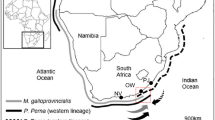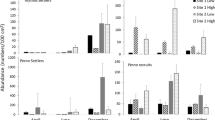Abstract
Despite well-documented negative impacts of invasive species on native biota, evidence for the facilitation of native organisms, particularly by habitat-forming invasive species, is increasing. However, most of these studies are conducted at the population or community level, and we know little about the individual fitness consequences of recruitment to habitat-forming invasive species and, consequently, whether recruitment to these habitats is adaptive. We determined the consequences of recruitment to the invasive green alga Caulerpa taxifolia on the native soft-sediment bivalve Anadara trapezia and nearby unvegetated sediment. Initially, we documented the growth and survivorship of A. trapezia following a natural recruitment event, to which recruitment to C. taxifolia was very high. After 12 months, few clams remained in either habitat, and those that remained showed little growth. Experimental manipulations of recruits demonstrated that all performance measures (survivorship, growth and condition) were significantly reduced in C. taxifolia sediments compared to unvegetated sediments. Exploration of potential mechanisms responsible for the reduced performance in C. taxifolia sediments showed that water flow and water column dissolved oxygen (DO) were significantly reduced under the canopy of C. taxifolia and that sediment anoxia was significantly higher and sediment sulphides greater in C. taxifolia sediments. However, phytoplankton abundance (an indicator of food supply) was significantly higher in C. taxifolia sediments than in unvegetated ones. Our results demonstrate that recruitment of native species to habitat-forming invasive species can reduce growth, condition and survivorship and that studies conducted at the community level may lead to erroneous conclusions about the impacts of invaders and should include studies on life-history traits, particularly juveniles.





Similar content being viewed by others
References
Abramoff MD, Magelhaes PJ, Ram SJ (2004) Image processing with ImageJ. Biophotonics Int 11:36–42
Allen BJ, Williams SL (2003) Native eelgrass Zostera marina controls growth and reproduction of an invasive mussel through food limitation. Mar Ecol Prog Ser 254:57–67
Anderson LW (2005) California’s reaction to Caulerpa taxifolia: a model for invasive species rapid response. Biol Invasions 7:1003–1006
Bellan-Santini D, Arnaud P, Bellan G, Verlaque M (1996) The influence of the introduced alga, Caulerpa taxifolia, on the biodiversity of the Mediterranean marine biota. J Mar Biol Assoc UK 76:235–237
Bologna PAX, Heck KL (1999) Differential predation and growth rates of bay scallops within a seagrass habitat. J Exp Mar Bio Ecol 239:299–314
Breitburg DL (1992) Episodic hypoxia in Chesapeake Bay: interacting effects of recruitment, behavior, and physical disturbance. Ecol Monogr 62:525–546
Carmichael RH, Shriver AC, Valiela I (2004) Changes in shell and soft tissue growth, tissue composition, and survival of quahogs, Mercenaria mercenaria, and softshell clams, Mya arenaria, in response to eutrophic-driven changes in food supply and habitat. J Exp Mar Biol Ecol 313:75–104
Castilla JC, Lagos NA, Cerda M (2004) Marine ecosystem engineering by the alien ascidian Pyura praeputialis on a mid-intertidal rocky shore. Mar Ecol Prog Ser 268:119–130
Ceccherelli G, Cinelli F (1997) Short-term effects of nutrient enrichment of the sediment and interactions between the seagrass Cymedocea nodosa and the introduced green alga Caulerpa taxifolia in a Mediterranean bay. J Exp Mar Biol Ecol 217:165–177
Chisholm JRM, Moulin P (2003) Stimulation of nitrogen fixation in refractory organic sediments by Caulerpa taxifolia (Chlorophyta). Limnol Oceanogr 48:787–794
Cline J (1969) Spectrophotometric determination of hydrogen sulfide in natural waters. Limnol Oceanogr 14:454–458
Connell JH (1961) The influence of interspecific competition and other factors on the distribution of the barnacle Chthamalus stellatus. Ecology 42:710–723
Creese RG, Davies AR, Glasby TM (2004) Eradicating and preventing the spread of the invasive alga Caulerpa taxifolia in NSW. NSW Fish Final Rep Ser 64:110
Crone EE (2001) Is survivorship a better surrogate than fecundity? Oikos 55:2611–2614
Crooks JA (1998) Habitat alteration and community-level effects of an exotic mussel, Musculista senhousia. Mar Ecol Prog Ser 162:137–152
Crooks JA (2001) Assessing invader roles within changing ecosystems: historical and experimental perspectives on an exotic mussel in an urbanized lagoon. Biol Invasions 3:23–36
Crooks JA (2002) Characterizing eco-system consequences of biological invasions: the role of ecosystem engineers. Oikos 97:137–152
Crooks JA, Khim HS (1999) Architectural vs. biological effects of a habitat-altering, exotic mussel, Musculista senhousia. J Exp Mar Biol Ecol 240:53–75
Cummins SP, Roberts DE, Ajani P, Underwood AJ (2004) Comparisons of assemblages of phytoplankton between open water and seagrass habitats in a shallow coastal lagoon. Mar Freshw Res 55:447–456
D’Avanzo C, Kremer JN (1994) Diel oxygen dynamics and anoxic events in an eutrophic estuary of Waquoit Bay, Massachusetts. Estuaries 17:131–139
Decker MB, Breitburg DL, Marcus NH (2003) Geographical differences in behavioral responses to hypoxia: local adaptation to an anthropogenic stressor? Ecol Appl 14:1104–1109
Deegan LA, Wright A, Ayvazian SG, Finn JT, Golden H, Rand Merson R, Harrison J (2002) Nitrogen loading alters seagrass ecosystem structure and support of higher trophic levels. Aquat Conserv Mar Freshw Ecosyst 12:193–212
Doty MS (1971) Measurements in water movement in reference to benthic algae growth. Bot Mar 14:32–35
Edgar GJ (2000) Australian marine life: the plants and animals of temperate waters. Reed New Holland, Sydney
Fossing H, Jorgensen BB (1989) Measurement of bacterial sulfate reduction in sediments: evaluation of single-step chromium reduction method. Biogeochemistry 8:205–222
Glasby TM, Creese RG (2007) Invasive marine species management and research. In: Connell SD, Gillanders BM (eds) Marine ecology. Oxford University Press, Melbourne, pp 569–594
Gribben PE, Wright JT (2006a) Invasive seaweed enhances recruitment of a native bivalve: roles of refuge from predation and habitat choice. Mar Ecol Prog Ser 318:177–185
Gribben PE, Wright JT (2006b) Sublethal effects on reproduction in native fauna: are females more vulnerable to biological invasion? Oecologia 149:352–361
Hacker SD, Dethier MN (2006) Community modification by a grass invader has differing impacts for marine habitats. Oikos 113:279–286
Hedge P, Kriwoken Lk (2000) Evidence for effects of Spartina anglica invasion on benthic macrofauna in Little Swanport Estuary, Tasmania. Austral Ecol 25:150–159
Howerton RD, Boyd CE (1992) Measurements of water circulation in ponds with gypsum blocks. Aquac Eng 11:141–155
Irlandi EA, Peterson CH (1991) Modification of animal habitat by large plants: mechanisms by which seagrasses influence clam growth. Oecologia 87:307–318
Keck RT, Maurer D, Lind H (1975) A comparative study of the hard clam gonad development cycle. Biol Bull 148:243–258
Levi F, Francour P (2004) Behavioural response of Mullus surmuletus to habitat modification by the invasive macroalga Caulerpa taxifolia. J Fish Biol 64:55–64
Levin LA, Neira C, Grosholz ED (2006) Invasive cordgrass modifies wetland trophic function. Ecology 87:419–432
Longepierre S, Robert A, Levi F, Francour P (2005) How an invasive alga species (Caulerpa taxifolia) induces changes in foraging strategies of the benthivorous fish Mullus surmuletus in coastal Mediterranean ecosystems. Biodivers Conserv 14:365–376
Mack RN, Simberloff D, Lonsdale WM, Evans H, Clout M, Bazzaz FA (2000) Biotic invasions: causes, epidemiology, global consequences, and control. Ecol Appl 10:689–710
Malouf RE, Bricelj VM (1989) Comparative biology of clams: environmental tolerances, feeding, and growth. In: Manzi J, Castagna M (eds) Clam mariculture in North America. Elsevier, Amsterdam, pp 23–73
Meinesz A, Belsher T, Thibaut T, Antolic B, Ben Mustapha K, Bourdouresque C-F, Chiaverini D, Cottalorda J-M, Djellouli A, El Abed A, Orestano C, Grau AM, Ivesa L, Jaklin L, Langar H, Massuti-Pascual E, Peirano A, Tunesi L, de Vaugelas J, Zavodnik N, Zuljevic A (2001) The introduced marine alga Caulerpa taxifolia in the Medtiterranean. Biol Invasions 38:499–508
Neira C, Levin LA, Grosholz ED (2005) Benthic macrofaunal communities of three sites in San Francisco Bay invaded by hybrid Spartina, with comparison to uninvaded habitats. Mar Ecol Prog Ser 292:111–126
Neira C, Grosholz ED, Levin LA, Blake R (2006) Mechanisms generating modification of benthos following tidal flat invasion by a Spartina hybrid. Ecol Appl 16:1391–1404
Nell JA, O’Connor WA, Heasman MP, Goard LJ (1994) Hatchery production for the venerid clam Katelysia rhytiphora (Lamy) and the Sydney cockle Anadara trapezia (Deshayes). Aquaculture 119:149–156
Patterson K, Nell J (1996) Estuarine clam farming in NSW. Austasia Aquac 10:52–53
Peterson CH, Estes JA (2001) Conservation and management of marine communities. In: Bertness MD, Gaines SD, Hay ME (eds) Marine community ecology. Sinuaer, Sunderland, pp 469–507
Posey MH (1988) Community changes associated with the spread of an introduced seagrass, Zostera japonica. Ecology 69:974–983
Quinn GP, Keough MJ (2002) Experimental design and data analysis for biologists. Cambridge University Press, Cambridge
Reusch TBH, Williams SL (1999) Macrophyte canopy structure and the success of an invasive marine bivalve. Oikos 84:398–416
Robertson BA, Hutto RL (2006) A framework for understanding ecological traps and an evaluation of existing evidence. Ecology 87:1075–1085
Rodriguez LF (2006) Can invasive species facilitate native species? Evidence of how, when, and why these impacts occur. Biol Invasions 8:927–939
Stearns SC (1992) The evolution of life histories. Oxford University Press, New York
Sullivan LA, Bush RT, McConchie DM (2000) A modified chromium-reducible sulfur method for reduced inorganic sulfur: optimum reaction time for acid sulfate soil. Aust J Soil Res 38:729–734
Swanson RL, Williamson JE, De Nys R, Kumar N, Bucknall MP (2004) Induction of settlement of larvae of the sea urchin Holopneustes purpurascens by histamine from its host plant. Biol Bull 206:161–172
Thompson TL, Glenn EP (1994) Plaster standards to measure water motion. Limnol Oceanogr 39:1768–1779
Ulstrup KE, Hill R, Ralph PJ (2005) Photosynthetic impact of hypoxia on in hospite zooxanthellae in the scleractinian coral Pocillopora damicornis. Mar Ecol Prog Ser 286:125–132
Underwood AJ (1997) Experiments in ecology. Cambridge University Press, Cambridge
Vitousek PM, D’Antonio CM, Loope LL, Westbrooks R (1996) Biological invasions as global environmental change. Am Sci 84:468–478
Williamson JE, Carson DG, De Nys R, Steinberg PD (2004) Demographic consequences of an ontogenetic shift by a sea urchin in response to host plant chemistry. Ecology 85:1355–1371
Winter JE (1978) A review of the knowledge of suspension-feeding in lamellibranchiate bivalves, with special reference to artificial aquaculture systems. Aquaculture 13:1–33
Wonham MJ, O’Connor M, Harley CDG (2005) Positive effects of a dominant invader on introduced and native mudflat species. Mar Ecol Prog Ser 289:109–116
Wright JT (2005) Differences between native and invasive Caulerpa taxifolia: a link between asexual fragmentation and abundance in invasive populations. Mar Biol 147:559–569
Wright JT, Davies AR (2006) Demographic feedback between clonal growth and fragmentation in an invasive seaweed. Ecology 87:1744–1754
Wright JT, Gribben PE (2008) Fitness response of fauna to an invasive seaweed: predictions of impact based on community structure alone are insufficient. J Appl Ecol 45:1540–1549
Wright JT, McKenzie LA, Gribben PE (2007) A decline in the density and health of a native bivalve associated with Caulerpa taxifolia invasion. Mar Freshw Res 58:263–277
York PH, Booth DJ, Glasby TM, Pease BC (2006) Fish assemblages in habitats dominated by Caulerpa taxifolia and native seagrasses in south-eastern Australia. Mar Ecol Prog Ser 312:223–234
Acknowledgments
We are grateful to Michael Clements for assistance with fieldwork and Louise McKenzie for assisting with fieldwork and video image analyses. Jeb Byers and two anonymous reviewers provided valuable comments which greatly improved the manuscript.
Author information
Authors and Affiliations
Corresponding author
Additional information
Communicated by Tony Underwood.
Rights and permissions
About this article
Cite this article
Gribben, P.E., Wright, J.T., O’Connor, W.A. et al. Reduced performance of native infauna following recruitment to a habitat-forming invasive marine alga. Oecologia 158, 733–745 (2009). https://doi.org/10.1007/s00442-008-1181-0
Received:
Accepted:
Published:
Issue Date:
DOI: https://doi.org/10.1007/s00442-008-1181-0




